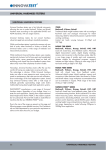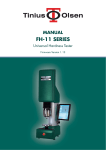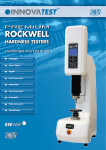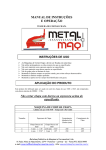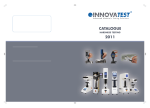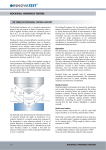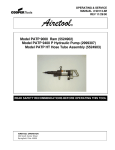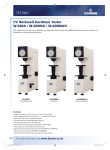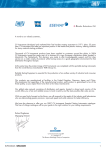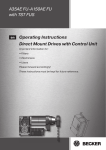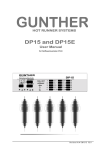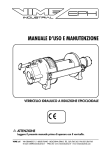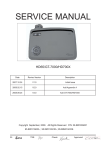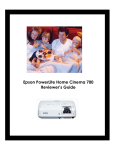Download Hardness Testing Instruments
Transcript
Bulletin 300 Hardness Testing Instruments Product Line Overview HARDNESS HARDNESS TESTER SERIES OVERVIEW Basic, load cell based Rockwell tester FH-30 Series FH-1 Series FH-2 Series FH-3 Series FH-10 Series FH-11 Series FH-12 Series Rockwell Hardness Testers Hardness is the property of a material enabling it to resist plastic deformation, usually by penetration of another object. The term “hardness” may also refer to stiffness, temper, or resistance to bending, scratching, abrasion, or cutting. Scientists and journalists often confuse stiffness with hardness and is demonstrated by, for example, the element Osmium, which is stiffer than diamond, but not as hard as diamond. In materials science there are three principal operational definitions of hardness: • Scratch hardness: Resistance to fracture or plastic (permanent) deformation due to friction from a sharp object • Indentation hardness: Resistance to plastic (permanent) deformation due to a constant load from a sharp object • Rebound hardness: Height or speed of the bounce of an object dropped on the material, related to elasticity. Measuring Hardness FH-1 Series FH-2 Series FH-4 Series FH-5 Series FH-9 Series FH-10 Series FH-11 Series FH-12 Series Vickers Hardness Testers FH-1 Series FH-2 Series FH-3 Series FH-9 Series FH-10 Series Brinell Hardness Testers FH-11 Series FH-12 Series Hardness is not an intrinsic material property. There are no precise definitions in terms of fundamental units of mass, length and time. A hardness property value is the result of a defined measurement procedure. Hardness of materials has long been assessed by resistance to scratching or cutting. An example would be material B scratches material C, but not material A. Alternatively, material A scratches material B slightly and scratches material C heavily. The usual method to obtain a hardness value is to measure the depth or area of an indentation left by an indentor of a specific shape, with a specific force applied for a specific time. There are several principal standard test methods to express the relationship between hardness and the size of the impression or the rebound velocity on specific materials. Vickers, Rockwell, Brinell and Leeb are the most common scales. For practical and calibration reasons, each of these methods is divided into a range of scales, defined by a combination of applied load and indentor geometry or in case of the rebound method, by the weight of the impact body. Most Common Hardness Tests FH-1 Series FH-2 Series FH-10 Series Universal Hardness Testers 2 FH-11 Series FH-12 Series Rockwell (HR scales) Indenting the test material with a diamond cone (HRC) or hardened (tungsten) steel ball indentor (HRB etc.) applying a preload of 10 kgf first and a main test force of 60, 100, or 150 kgf. Rockwell Superficial (HR scales) Indenting the test material with a diamond cone or hardened (tungsten) steel ball indentor, depending on the scale preliminary set. The Superficial Rockwell scales use lower force and shallower impressions on brittle and very thin materials. Applying a preload of 3 kgf first and a main test force of 15, 30, or 45 kgf. Vickers (HV) Indenting the test material with a diamond indentor, in the form of an upside down perfect pyramid with a square base and an angle of 136 degrees between opposite faces, subjected to test forces of 1 to 120 kgf. A microscope or USB camera is used to visualize and measure the indentation. Micro-Vickers (HV) Indenting the test material with a diamond indentor, in the form of an upside down perfect pyramid with a square base and an angle of 136 degrees between opposite faces, subjected to test forces usually not exceeding 1 kgf. A precision micro scope or high resolution USB camera is used to visualize and measure the indentations, magnifications up to 600x are most common. However, magnifications up to 1000x are becoming popular as well. Knoop (HK) Indenting the test material with a “elongated” diamond pyramid, subjected to test forces usually not exceeding 1 kgf. A precision micro scope or high resolution USB camera is used to visualize and measure the indentations, magnifications up to 600x are most common. Brinell (HB) Indenting the to be tested material with a 1, 2.5, 5, or 10 mm diameter hardened steel or carbide ball subjected to a load/force ranging from 1 to 3000 kg. A microscope or USB camera is used to visualize and measure the rather large indentations. Leeb (HL) (rebound method) Portable hardness testing. An impact body that has a spherical tungsten carbide tip, is impelled onto the test surface by spring force. The impact creates a plastic deformation of the surface, an indentation, due to which the impact body loses part of its original speed (or energy). Consequently, the softer the material is, the more speed will be lost at rebound of the impact body. Applicable for a wide variety of components. Minimum test requirements should be obeyed. Ultrasonic (UCI) Portable hardness testing. A Vickers shaped diamond indentor fixed on a vibrating rod that presses on the test surface with a specific force and then measures its hardness by applying ultrasonic vibrations and analyzing its damping effect. Commonly used for small, thin components that cannot be tested by rebound hardness testers. Shore (HS scales) Portable (rubber/plastics) hardness testing. The hardness value is determined by pressing the indentor foot firmly onto the sample. The indentor is connected to a linear measuring device and measures the indent depth, which is then converted through a mechanical or an electronical system to the Shore value. The deeper the indent, the softer the material. IRHD Measures the indentation resistance of elastomeric or rubber materials based on the depth of penetration of a ball indentor. An initial contact force is applied to a 1, 2.5, or 5 mm ball indentor and the penetration is set to zero. The force is increased to a specified total load and the depth of the penetration is measured. The IRHD value is related to the depth of indentor penetration. The method is commonly used for testing small parts and O-rings. Webster Portable hardness testing. The object to be tested is placed between the anvil and the penetrator. Pressure is then applied to the handles until “bottom” is felt, at which time the dial indicator is read. There are different types of indentors and different force settings for different materials. Less Common Hardness Scales The following hardness methods are less frequently used or superseded by other methods: • HM – Martens (formerly HU – universal hardness) • H – ball indentation hardness • HVT – modified Vickers method, depth measurement • HBT – modified Brinell method, depth measurement 3 HARDNESS HARDNESS TESTER SERIES OVERVIEW Basic, load cell based Rockwell tester FH-30 Series FH-1 Series FH-2 Series FH-3 Series FH-10 Series FH-11 Series FH-12 Series Rockwell Hardness Testers Hardness is the property of a material enabling it to resist plastic deformation, usually by penetration of another object. The term “hardness” may also refer to stiffness, temper, or resistance to bending, scratching, abrasion, or cutting. Scientists and journalists often confuse stiffness with hardness and is demonstrated by, for example, the element Osmium, which is stiffer than diamond, but not as hard as diamond. In materials science there are three principal operational definitions of hardness: • Scratch hardness: Resistance to fracture or plastic (permanent) deformation due to friction from a sharp object • Indentation hardness: Resistance to plastic (permanent) deformation due to a constant load from a sharp object • Rebound hardness: Height or speed of the bounce of an object dropped on the material, related to elasticity. Measuring Hardness FH-1 Series FH-2 Series FH-4 Series FH-5 Series FH-9 Series FH-10 Series FH-11 Series FH-12 Series Vickers Hardness Testers FH-1 Series FH-2 Series FH-3 Series FH-9 Series FH-10 Series Brinell Hardness Testers FH-11 Series FH-12 Series Hardness is not an intrinsic material property. There are no precise definitions in terms of fundamental units of mass, length and time. A hardness property value is the result of a defined measurement procedure. Hardness of materials has long been assessed by resistance to scratching or cutting. An example would be material B scratches material C, but not material A. Alternatively, material A scratches material B slightly and scratches material C heavily. The usual method to obtain a hardness value is to measure the depth or area of an indentation left by an indentor of a specific shape, with a specific force applied for a specific time. There are several principal standard test methods to express the relationship between hardness and the size of the impression or the rebound velocity on specific materials. Vickers, Rockwell, Brinell and Leeb are the most common scales. For practical and calibration reasons, each of these methods is divided into a range of scales, defined by a combination of applied load and indentor geometry or in case of the rebound method, by the weight of the impact body. Most Common Hardness Tests FH-1 Series FH-2 Series FH-10 Series Universal Hardness Testers 2 FH-11 Series FH-12 Series Rockwell (HR scales) Indenting the test material with a diamond cone (HRC) or hardened (tungsten) steel ball indentor (HRB etc.) applying a preload of 10 kgf first and a main test force of 60, 100, or 150 kgf. Rockwell Superficial (HR scales) Indenting the test material with a diamond cone or hardened (tungsten) steel ball indentor, depending on the scale preliminary set. The Superficial Rockwell scales use lower force and shallower impressions on brittle and very thin materials. Applying a preload of 3 kgf first and a main test force of 15, 30, or 45 kgf. Vickers (HV) Indenting the test material with a diamond indentor, in the form of an upside down perfect pyramid with a square base and an angle of 136 degrees between opposite faces, subjected to test forces of 1 to 120 kgf. A microscope or USB camera is used to visualize and measure the indentation. Micro-Vickers (HV) Indenting the test material with a diamond indentor, in the form of an upside down perfect pyramid with a square base and an angle of 136 degrees between opposite faces, subjected to test forces usually not exceeding 1 kgf. A precision micro scope or high resolution USB camera is used to visualize and measure the indentations, magnifications up to 600x are most common. However, magnifications up to 1000x are becoming popular as well. Knoop (HK) Indenting the test material with a “elongated” diamond pyramid, subjected to test forces usually not exceeding 1 kgf. A precision micro scope or high resolution USB camera is used to visualize and measure the indentations, magnifications up to 600x are most common. Brinell (HB) Indenting the to be tested material with a 1, 2.5, 5, or 10 mm diameter hardened steel or carbide ball subjected to a load/force ranging from 1 to 3000 kg. A microscope or USB camera is used to visualize and measure the rather large indentations. Leeb (HL) (rebound method) Portable hardness testing. An impact body that has a spherical tungsten carbide tip, is impelled onto the test surface by spring force. The impact creates a plastic deformation of the surface, an indentation, due to which the impact body loses part of its original speed (or energy). Consequently, the softer the material is, the more speed will be lost at rebound of the impact body. Applicable for a wide variety of components. Minimum test requirements should be obeyed. Ultrasonic (UCI) Portable hardness testing. A Vickers shaped diamond indentor fixed on a vibrating rod that presses on the test surface with a specific force and then measures its hardness by applying ultrasonic vibrations and analyzing its damping effect. Commonly used for small, thin components that cannot be tested by rebound hardness testers. Shore (HS scales) Portable (rubber/plastics) hardness testing. The hardness value is determined by pressing the indentor foot firmly onto the sample. The indentor is connected to a linear measuring device and measures the indent depth, which is then converted through a mechanical or an electronical system to the Shore value. The deeper the indent, the softer the material. IRHD Measures the indentation resistance of elastomeric or rubber materials based on the depth of penetration of a ball indentor. An initial contact force is applied to a 1, 2.5, or 5 mm ball indentor and the penetration is set to zero. The force is increased to a specified total load and the depth of the penetration is measured. The IRHD value is related to the depth of indentor penetration. The method is commonly used for testing small parts and O-rings. Webster Portable hardness testing. The object to be tested is placed between the anvil and the penetrator. Pressure is then applied to the handles until “bottom” is felt, at which time the dial indicator is read. There are different types of indentors and different force settings for different materials. Less Common Hardness Scales The following hardness methods are less frequently used or superseded by other methods: • HM – Martens (formerly HU – universal hardness) • H – ball indentation hardness • HVT – modified Vickers method, depth measurement • HBT – modified Brinell method, depth measurement 3 FH-1 SERIES ROCKWELL AND UNIVERSAL HARDNESS TESTERS FH-2 SERIES ROCKWELL AND UNIVERSAL HARDNESS TESTERS MODEL FH-1-0 MODEL FH-2-0 Rockwell •Load cell based, closed loop operation • Advanced user interface • Scales: Basic Rockwell • Automatic testing procedure •Conversion to all other hardness scales • Convex and concave testmodus • Database for test programs • Large workpiece accommodation • On-line statistics • USB output MODEL FH-1-1 Rockwell and Superficial Rockwell •Scales: Rockwell: A, B, C, D, E, F, G, H, K, L, M, P, R, S, V Superficial Rockwell: 15N, 30N, 45N, 15T, 30T, 45T, 15W, 30W, 45W, 15X, 30X, 45X, 15Y, 30Y, 45Y MODEL FH-1-2 Rockwell, Superficial Rockwell, and Brinell Optional Accessories for FH-1 Series Rockwell, Superficial Rockwell, HBT, HVT, and H ball indentation •Full color multi function touch screen controller •Load cell based, closed loop operation • Advanced user interface • Scales: Rockwell - A, B, C, D, E, F, G, H, K, L, M, P, R, S, V, Superficial Rockwell -15N, 30N, 45N, 15T, 30T, 45T, 15W, 30W, 45W, 15X, 30X, 45X, 15Y, 30Y, 45Y; Brinell - HBT2.5/62.5, 187.5 kgf; HBT5/250 kgf; Vickers - HVT 50, 100 kgf •Motorised elevator spindle (optional) • Automatic testing procedure •Conversion to all other hardness scales • Convex and concave testmodus • Database for test programs • Large workpiece accommodation • On-line statistics • USB output • Certified hardness test block ±450HV (FH-1-3) • Certified hardness test block ±200HB (FH-1-2/ FH-1-3) • Certified hardness test block ±60HRC • Certified hardness test block ±30HRC • Certified hardness test block ±85HRB • Motorised elevator spindle • Rockwell diamond cone 120° • Vickers diamond cone 136° (FH-1-3) • Rockwell ball indentor 1.6 mm (1/16") • Brinell balls indentors 1 mm, 2.5 mm, 5 mm, 10 mm (.04, .10, .20, .39") (FH-1-2/FH-1-3) • V-Anvil 60 mm (2.36") • Long indentors • Goose neck indentor holder • Large testing table 300 x 200 mm (11.81 x 7.87") with T-slot • Custom testing tables • Precision vices, V-blocks, and special clamps Same features as FH-1-1, but with additional Brinell scales •Additional Scales: Brinell: HB1/1, 2.5, 5, 10, 30 kgf; HB2.5/6.25, 15.625, 31.25, 62.5, 87.5 kgf; HB5/ 25, 62.5, 125, 250 kgf; HB10/ 100, 250 kgf •Brinell microscope with LED ring light MODEL FH-2-1 Fig 1. Model FH-1-1 MODEL FH-1-3 Rockwell, Superficial Rockwell, Brinell, Vickers, HBT, and HVT Same features as FH-1-2, but with additional Vickers scales •Scales: Brinell: HBT2.5/62.5, 187.5 kgf; HBT5/250 kgf; Vickers: HV 1, 2, 3, 5, 10, 20, 30, 50, 100, 120; HVT 50, 100 kgf •Built-on electronic digital microscope for Brinell and Vickers indent measurement •Objectives 2.5x, 5x, 10x magnification • Adjustable LED illumination • LED Ringlight (optional) • Precision workpiece sliding table • Large workpiece accommodation Fig 2. Model FH-1-3 Rockwell, Superficial Rockwell, Brinell, Vickers, Knoop, HBT, and HVT Same features as FH-2-0 but with the following additional features: •CCD USB Video system, manual and automatic measurement of Brinell and Vickers/Knoop indentations, indent Video zoom function • Scales: Brinell - HB1/1, 2.5, 5, 10, 30 kgf; HB2.5/6.25, 15.625, 31.25, 62.5, 187.5 kgf; HB5/ 25, 62.5, 125, 250 kgf; HB10/ 100, 250 kgf; HBT2.5/62.5, 187.5 kgf; HBT5/250 kgf Vickers - HV 1, 2, 3, 5, 10, 20, 30, 50, 100, 120 •Built-on electronic digital microscope for Brinell and Vickers indent measurement •Objectives 2.5x, 5x, 10x magnification • Adjustable LED illumination • Precision workpiece sliding table Optional Accessories for FH-2 Series •Certified hardness test block ±450HV (FH-2-1) •Certified hardness test block ±200HB (FH-2-1) •Certified hardness test block ±60HRC •Certified hardness test block ±30HRC •Certified hardness test block ±85HRB •Rockwell diamond cone 120° •Vickers diamond cone 136° (FH-2-1) •Rockwell ball indentor 1.6 mm (1/16") •Brinell balls indentors 1 mm, 2.5 mm, 5 mm, 10 mm (.04, .10, .20, .31") (FH-2-1) •Knoop hardness testing scale (FH-2-1) • V-Anvil hardened, 60 mm (2.36") • Long indentors • Goose neck indentor holder •Large testing table 300 x 200 mm (11.81 X 7.87") with T-slot • Custom testing tables •Precision vices, V-blocks, and special clamps • LED Ringlight Fig 3. Model FH-2-0 Fig 2A. Model FH-1-3 from Side Fig 4. Model FH-2-1 4 Fig. 4A. Model FH2-1 from Side 5 FH-1 SERIES ROCKWELL AND UNIVERSAL HARDNESS TESTERS FH-2 SERIES ROCKWELL AND UNIVERSAL HARDNESS TESTERS MODEL FH-1-0 MODEL FH-2-0 Rockwell •Load cell based, closed loop operation • Advanced user interface • Scales: Basic Rockwell • Automatic testing procedure •Conversion to all other hardness scales • Convex and concave testmodus • Database for test programs • Large workpiece accommodation • On-line statistics • USB output MODEL FH-1-1 Rockwell and Superficial Rockwell •Scales: Rockwell: A, B, C, D, E, F, G, H, K, L, M, P, R, S, V Superficial Rockwell: 15N, 30N, 45N, 15T, 30T, 45T, 15W, 30W, 45W, 15X, 30X, 45X, 15Y, 30Y, 45Y MODEL FH-1-2 Rockwell, Superficial Rockwell, and Brinell Optional Accessories for FH-1 Series Rockwell, Superficial Rockwell, HBT, HVT, and H ball indentation •Full color multi function touch screen controller •Load cell based, closed loop operation • Advanced user interface • Scales: Rockwell - A, B, C, D, E, F, G, H, K, L, M, P, R, S, V, Superficial Rockwell -15N, 30N, 45N, 15T, 30T, 45T, 15W, 30W, 45W, 15X, 30X, 45X, 15Y, 30Y, 45Y; Brinell - HBT2.5/62.5, 187.5 kgf; HBT5/250 kgf; Vickers - HVT 50, 100 kgf •Motorised elevator spindle (optional) • Automatic testing procedure •Conversion to all other hardness scales • Convex and concave testmodus • Database for test programs • Large workpiece accommodation • On-line statistics • USB output • Certified hardness test block ±450HV (FH-1-3) • Certified hardness test block ±200HB (FH-1-2/ FH-1-3) • Certified hardness test block ±60HRC • Certified hardness test block ±30HRC • Certified hardness test block ±85HRB • Motorised elevator spindle • Rockwell diamond cone 120° • Vickers diamond cone 136° (FH-1-3) • Rockwell ball indentor 1.6 mm (1/16") • Brinell balls indentors 1 mm, 2.5 mm, 5 mm, 10 mm (.04, .10, .20, .39") (FH-1-2/FH-1-3) • V-Anvil 60 mm (2.36") • Long indentors • Goose neck indentor holder • Large testing table 300 x 200 mm (11.81 x 7.87") with T-slot • Custom testing tables • Precision vices, V-blocks, and special clamps Same features as FH-1-1, but with additional Brinell scales •Additional Scales: Brinell: HB1/1, 2.5, 5, 10, 30 kgf; HB2.5/6.25, 15.625, 31.25, 62.5, 87.5 kgf; HB5/ 25, 62.5, 125, 250 kgf; HB10/ 100, 250 kgf •Brinell microscope with LED ring light MODEL FH-2-1 Fig 1. Model FH-1-1 MODEL FH-1-3 Rockwell, Superficial Rockwell, Brinell, Vickers, HBT, and HVT Same features as FH-1-2, but with additional Vickers scales •Scales: Brinell: HBT2.5/62.5, 187.5 kgf; HBT5/250 kgf; Vickers: HV 1, 2, 3, 5, 10, 20, 30, 50, 100, 120; HVT 50, 100 kgf •Built-on electronic digital microscope for Brinell and Vickers indent measurement •Objectives 2.5x, 5x, 10x magnification • Adjustable LED illumination • LED Ringlight (optional) • Precision workpiece sliding table • Large workpiece accommodation Fig 2. Model FH-1-3 Rockwell, Superficial Rockwell, Brinell, Vickers, Knoop, HBT, and HVT Same features as FH-2-0 but with the following additional features: •CCD USB Video system, manual and automatic measurement of Brinell and Vickers/Knoop indentations, indent Video zoom function • Scales: Brinell - HB1/1, 2.5, 5, 10, 30 kgf; HB2.5/6.25, 15.625, 31.25, 62.5, 187.5 kgf; HB5/ 25, 62.5, 125, 250 kgf; HB10/ 100, 250 kgf; HBT2.5/62.5, 187.5 kgf; HBT5/250 kgf Vickers - HV 1, 2, 3, 5, 10, 20, 30, 50, 100, 120 •Built-on electronic digital microscope for Brinell and Vickers indent measurement •Objectives 2.5x, 5x, 10x magnification • Adjustable LED illumination • Precision workpiece sliding table Optional Accessories for FH-2 Series •Certified hardness test block ±450HV (FH-2-1) •Certified hardness test block ±200HB (FH-2-1) •Certified hardness test block ±60HRC •Certified hardness test block ±30HRC •Certified hardness test block ±85HRB •Rockwell diamond cone 120° •Vickers diamond cone 136° (FH-2-1) •Rockwell ball indentor 1.6 mm (1/16") •Brinell balls indentors 1 mm, 2.5 mm, 5 mm, 10 mm (.04, .10, .20, .31") (FH-2-1) •Knoop hardness testing scale (FH-2-1) • V-Anvil hardened, 60 mm (2.36") • Long indentors • Goose neck indentor holder •Large testing table 300 x 200 mm (11.81 X 7.87") with T-slot • Custom testing tables •Precision vices, V-blocks, and special clamps • LED Ringlight Fig 3. Model FH-2-0 Fig 2A. Model FH-1-3 from Side Fig 4. Model FH-2-1 4 Fig. 4A. Model FH2-1 from Side 5 FH-3 SERIES ROCKWELL HARDNESS TESTERS MODEL FH-3-0 Rockwell, Superficial Rockwell, HVT, and HBT • Load cell, closed loop • Advanced user interface • Scales: Rockwell: A, B, C, D, E, F, G, H, K, L, M, P, R, S, V • Automatic testing procedure •Conversion to all other hardness scales • Convex and concave testmodus • Database for test programs • Large workpiece accommodation • On-line statistics • USB output Supplied as Standard With • Data output RS-232C • V-anvil ø40 mm (1.57") • Testing table large ø150 mm (5.9") • Power cable • Spare fuse • Adjustable feet (4 Pcs) • Spindle protection cover • Machine cover • Solid accessories case • Certificate • User and installation manual Optional Accessories • Built-in thermal printer •Cerified Diamond Rockwell indentor •Certified Rockwell ball indentor 1.58 mm (1/16") • Rockwell testing balls •Certified hardness test blocks: ±60 HRC, ±40 HRC, ±85 HRB Fig 5. Model FH-3-0 6 ROCKWELL HARDNESS EXPLAINED The Rockwell Hardness test is a hardness measurement based on the net increase in depth of impression when a load is applied. Hardness values are commonly given in the A, B, C, R, L, M, E and K scales. The higher the value in each of the scales, the harder the material. Hardness has been variously defined as resistance to local penetration, scratching, machining, wear or abrasion. In the Rockwell method of hardness testing, the depth of penetration of an indentor under certain arbitrary test conditions is determined. The indentor may either be a steel (carbide) ball of some specified diameter or a spherical diamond-tipped cone of 118° angle and 0.2 mm tip radius also called indentor. The type of indentor and the test load determine the hardness scale (A, B, C, etc.). A minor load of 3 kg or 10 kg is first applied, causing an initial penetration and holding the indentor in place. Then, the dial is set to zero and the major load is applied. Upon removal of the major load, the depth reading is taken while the minor load is still on. The hardness number may then be read directly from the scale. The Rockwell scale characterizes the indentation hardness of materials through the depth of penetration of an indentor, loaded on a material sample and compared to the penetration in some reference material. It is one of several definitions of hardness in materials science. Its hardness values are noted by HR and ’X’ is the letter for the scale used. Hardness relation to strength is that both are measures of the pressure it takes to get plastic deformation to occur in materials. The Rockwell hardness test was devised by metallurgist Stanley P. Rockwell in Syracuse, NY, around 1919, in order to quickly determine the effects of heat treatment on steel bearing races. The Brinell hardness test, invented in 1900 in Sweden, was slow, not useful on fully hardened steel, and left too large impressions to be considered nondestructive. Rockwell collaborated with an instrument manufacturer to commercialize his invention and develop standardized testing machines. Fig 6. Rockwell Measurement Operation Scales and Values The determination of the Rockwell hardness of a material involves the application of a minor load followed by a major load, and then noting the depth of penetration, converted to a hardness value directly from a dial or display, in which a harder material gives a higher number. The major advantage of Rockwell hardness is its ability to display hardness values directly, thus obviating tedious calculations involved in other hardness measurement techniques. Also, the relatively simple and inexpensive set-up enables installation under various conditions. Rockwell testers are typically used in engineering, metallurgy, and industrial environments. The commercial popularity arises from its speed, reliability, robustness, resolution, and small area of indentation. The most common used are the “C”, and “B” scales. Both express hardness as an arbitrary dimensionless number. The B-scale is used for softer materials (such as aluminium, brass, and softer steels). It employs a tungsten carbide ball as the indentor and a 100-kg weight to obtain a value expressed as “HRB”. The C-scale, for harder materials, uses a diamond cone and a 150-kg weight to obtain a value expressed as “HRC”. There are several alternative scales for other purposes. The superficial Rockwell scales use lower loads and shallower impressions on brittle and very thin materials. The 45N scale employs a 45-kg load on a diamond coneshaped Brale indentor, and can be used on dense ceramics. The 15T scale employs a 15-kg load on a 1/16-inch diameter hardened steel ball, and can be used on sheet metal. Readings below HRC 20 are generally considered unreliable, as are readings much above HRB 100. Good Practices The following procedures are all important: cleaning indentor and test-piece to be clear of dirt, grease, rust, or paint; measuring on a perpendicular, flat surface (round work correction factors are invoked to adjust for test-piece curvature); ensuring that the thickness of the test-piece is at least 10 times the depth of the indentation; maintaining an adequate spacing between multiple indentations; and controlling the speed of indentation and assuring that the load duration (dwell) time is applied correctly. Typical Values Very hard steel (e.g. a good knife blade): HRC 55 - HRC 62; Axes, chisels, etc.: HRC 40 - 45 Several other scales, including the extensive A-scale, are used for specialized applications. There are special scales for measuring casehardened specimens. 7 FH-3 SERIES ROCKWELL HARDNESS TESTERS MODEL FH-3-0 Rockwell, Superficial Rockwell, HVT, and HBT • Load cell, closed loop • Advanced user interface • Scales: Rockwell: A, B, C, D, E, F, G, H, K, L, M, P, R, S, V • Automatic testing procedure •Conversion to all other hardness scales • Convex and concave testmodus • Database for test programs • Large workpiece accommodation • On-line statistics • USB output Supplied as Standard With • Data output RS-232C • V-anvil ø40 mm (1.57") • Testing table large ø150 mm (5.9") • Power cable • Spare fuse • Adjustable feet (4 Pcs) • Spindle protection cover • Machine cover • Solid accessories case • Certificate • User and installation manual Optional Accessories • Built-in thermal printer •Cerified Diamond Rockwell indentor •Certified Rockwell ball indentor 1.58 mm (1/16") • Rockwell testing balls •Certified hardness test blocks: ±60 HRC, ±40 HRC, ±85 HRB Fig 5. Model FH-3-0 6 ROCKWELL HARDNESS EXPLAINED The Rockwell Hardness test is a hardness measurement based on the net increase in depth of impression when a load is applied. Hardness values are commonly given in the A, B, C, R, L, M, E and K scales. The higher the value in each of the scales, the harder the material. Hardness has been variously defined as resistance to local penetration, scratching, machining, wear or abrasion. In the Rockwell method of hardness testing, the depth of penetration of an indentor under certain arbitrary test conditions is determined. The indentor may either be a steel (carbide) ball of some specified diameter or a spherical diamond-tipped cone of 118° angle and 0.2 mm tip radius also called indentor. The type of indentor and the test load determine the hardness scale (A, B, C, etc.). A minor load of 3 kg or 10 kg is first applied, causing an initial penetration and holding the indentor in place. Then, the dial is set to zero and the major load is applied. Upon removal of the major load, the depth reading is taken while the minor load is still on. The hardness number may then be read directly from the scale. The Rockwell scale characterizes the indentation hardness of materials through the depth of penetration of an indentor, loaded on a material sample and compared to the penetration in some reference material. It is one of several definitions of hardness in materials science. Its hardness values are noted by HR and ’X’ is the letter for the scale used. Hardness relation to strength is that both are measures of the pressure it takes to get plastic deformation to occur in materials. The Rockwell hardness test was devised by metallurgist Stanley P. Rockwell in Syracuse, NY, around 1919, in order to quickly determine the effects of heat treatment on steel bearing races. The Brinell hardness test, invented in 1900 in Sweden, was slow, not useful on fully hardened steel, and left too large impressions to be considered nondestructive. Rockwell collaborated with an instrument manufacturer to commercialize his invention and develop standardized testing machines. Fig 6. Rockwell Measurement Operation Scales and Values The determination of the Rockwell hardness of a material involves the application of a minor load followed by a major load, and then noting the depth of penetration, converted to a hardness value directly from a dial or display, in which a harder material gives a higher number. The major advantage of Rockwell hardness is its ability to display hardness values directly, thus obviating tedious calculations involved in other hardness measurement techniques. Also, the relatively simple and inexpensive set-up enables installation under various conditions. Rockwell testers are typically used in engineering, metallurgy, and industrial environments. The commercial popularity arises from its speed, reliability, robustness, resolution, and small area of indentation. The most common used are the “C”, and “B” scales. Both express hardness as an arbitrary dimensionless number. The B-scale is used for softer materials (such as aluminium, brass, and softer steels). It employs a tungsten carbide ball as the indentor and a 100-kg weight to obtain a value expressed as “HRB”. The C-scale, for harder materials, uses a diamond cone and a 150-kg weight to obtain a value expressed as “HRC”. There are several alternative scales for other purposes. The superficial Rockwell scales use lower loads and shallower impressions on brittle and very thin materials. The 45N scale employs a 45-kg load on a diamond coneshaped Brale indentor, and can be used on dense ceramics. The 15T scale employs a 15-kg load on a 1/16-inch diameter hardened steel ball, and can be used on sheet metal. Readings below HRC 20 are generally considered unreliable, as are readings much above HRB 100. Good Practices The following procedures are all important: cleaning indentor and test-piece to be clear of dirt, grease, rust, or paint; measuring on a perpendicular, flat surface (round work correction factors are invoked to adjust for test-piece curvature); ensuring that the thickness of the test-piece is at least 10 times the depth of the indentation; maintaining an adequate spacing between multiple indentations; and controlling the speed of indentation and assuring that the load duration (dwell) time is applied correctly. Typical Values Very hard steel (e.g. a good knife blade): HRC 55 - HRC 62; Axes, chisels, etc.: HRC 40 - 45 Several other scales, including the extensive A-scale, are used for specialized applications. There are special scales for measuring casehardened specimens. 7 FH-4 SERIES MICRO-VICKERS HARDNESS TESTERS FH-5 SERIES VICKERS HARDNESS TESTERS MODEL FH-4-1 DIGITAL MICROSCOPE, 2 KGF TEST FORCE FH-5 SERIES MODEL FH-5-4 Micro-Vickers, Vickers, Knoop, and low force Brinell •Load cell, closed loop, force feed back system •Motorised turret with 2 or 3 objectives •Test loads 20 g - 31.25 kgf •Conversion to other hardness scales including Tensile Strength •Digital eyepiece and camera adaptor •Large LCD display shows measured values, on-line statistics, memory overview, tester settings Micro / Macro Vickers, Knoop and Brinell Micro-Vickers and Knoop • Motorized turret, 3 objectives • Test loads 10 g -2 kgf •Electronic microscope, digital value transfer •Large LCD display shows measured values, on-line statistics, memory overview, tester settings • Large workpiece accommodation • RS-232 output • Built-in printer Supplied as Standard With MODEL FH-5-6 Vickers and Brinell (low force with 1, 2, and 5 mm ball) MODEL FH-5-7 •Test loads of: 1, 2, 2.5, 3, 4, 5, 6.25, 10, 15.625, 20, 31.25 kgf MODEL FH-5-2 Micro / Macro Vickers and Knoop •Test loads of: 0.3, 0.5, 1, 2, 2.5, 3, 4, 5, 10, 20, 30 kgf • Selection of Objectives •Horizon - manual or automatic measuring and filing systems •Motorised X-Y stage (small or large) • Motorised X-Y-Z stage (auto focus) • Indentors and hardness test blocks • Certified indentors • Reference hardness blocks •Solid tester table and storage cabinet •Test loads of: 1, 2, 2.5, 3, 4, 5, 10, 20, 30, 50 kgf •Test loads of: 1, 2, 2.5, 3, 4, 5, 10, 20, 30 kgf Vickers and Brinell (low force with 1 and 2 mm ball) Optional Accessories Macro Vickers and Knoop Vickers and Knoop MODEL FH-5-1 Fig 7. Model FH-4-0 MODEL FH-5-5 •Test loads of: 1, 2, 2.5, 3, 4, 5, 6.25, 10, 15.625, 20, 31.25, 62.5 kgf MODEL FH-5-0 • Manual X-Y stage •Objectives according to model (10x and 40x or 10x, 20x and 40x) • Digital Electronic microscope 15x • Built-in silent thermal printer • RS-232 data output •Set of workpiece fixtures, vice, chuck, clamp • Level gauge • 4 adjustable feet • Spare halogen lamp • Installation and user manual • Certificate •Test loads of: As plus 6.25, 15.625, 31.25 kgf MODEL FH-5-3 Micro / Macro Vickers and Knoop Micro / Macro Vickers and Knoop •Test loads of: 0.3, 0.5, 1, 2, 2.5, 3, 4, 5, 10, 20, 30, 50 kgf Fig 9. Model FH-5-0 MODEL FH-5-8 Micro / Macro Vickers and Knoop •Test loads of: 0.1, 0.2, 0.3, 0.5, 1, 2, 2.5, 3, 4, 5, 10, 20, 30, 50 kgf MODEL FH-5-9 Micro / Macro Vickers, Knoop and Brinell •Test loads of: As FH-5-8 plus 6.25, 15.625, 31.25, 62.5 kgf •Test loads of: 0.02, 0.025, 0.05, 0.1, 0.2, 0.3, 0.5, 1, 2, 2.5, 3, 4, 5, 10, 20, 30 kgf Supplied as Standard With • Manual X-Y stage • Flat anvil 60 mm • Objectives 5x, 10x, 20x or 10x, 20x, 40x • Electronic digital eyepiece 15x • Set of workpiece fixtures, vice, chuck, clamp • Built-in thermal printer • RS-232 data output • 4 adjustable feet • Spare halogen lamp • Fuse • Installation and user manual • Certificate Optional Accessories • Objectives 5x, 40x, 60x • Horizon Vision measuring and filing systems • Motorised X-Y stage (small or large) • Motorised X-Y-Z stage (auto focus) • Indentors and hardness test blocks • Certified indentors • Reference hardness blocks • Solid tester table and storage cabinet Fig 8. Model FH-4, Shown with Optional Motorised X-Y Stage 8 Analogue Digital Motorised, small Motorised, large Fig 10. Model FH-5-3 Shown with Small Motorised Table and Horizon Vision Measuring and Filing System 9 FH-4 SERIES MICRO-VICKERS HARDNESS TESTERS FH-5 SERIES VICKERS HARDNESS TESTERS MODEL FH-4-1 DIGITAL MICROSCOPE, 2 KGF TEST FORCE FH-5 SERIES MODEL FH-5-4 Micro-Vickers, Vickers, Knoop, and low force Brinell •Load cell, closed loop, force feed back system •Motorised turret with 2 or 3 objectives •Test loads 20 g - 31.25 kgf •Conversion to other hardness scales including Tensile Strength •Digital eyepiece and camera adaptor •Large LCD display shows measured values, on-line statistics, memory overview, tester settings Micro / Macro Vickers, Knoop and Brinell Micro-Vickers and Knoop • Motorized turret, 3 objectives • Test loads 10 g -2 kgf •Electronic microscope, digital value transfer •Large LCD display shows measured values, on-line statistics, memory overview, tester settings • Large workpiece accommodation • RS-232 output • Built-in printer Supplied as Standard With MODEL FH-5-6 Vickers and Brinell (low force with 1, 2, and 5 mm ball) MODEL FH-5-7 •Test loads of: 1, 2, 2.5, 3, 4, 5, 6.25, 10, 15.625, 20, 31.25 kgf MODEL FH-5-2 Micro / Macro Vickers and Knoop •Test loads of: 0.3, 0.5, 1, 2, 2.5, 3, 4, 5, 10, 20, 30 kgf • Selection of Objectives •Horizon - manual or automatic measuring and filing systems •Motorised X-Y stage (small or large) • Motorised X-Y-Z stage (auto focus) • Indentors and hardness test blocks • Certified indentors • Reference hardness blocks •Solid tester table and storage cabinet •Test loads of: 1, 2, 2.5, 3, 4, 5, 10, 20, 30, 50 kgf •Test loads of: 1, 2, 2.5, 3, 4, 5, 10, 20, 30 kgf Vickers and Brinell (low force with 1 and 2 mm ball) Optional Accessories Macro Vickers and Knoop Vickers and Knoop MODEL FH-5-1 Fig 7. Model FH-4-0 MODEL FH-5-5 •Test loads of: 1, 2, 2.5, 3, 4, 5, 6.25, 10, 15.625, 20, 31.25, 62.5 kgf MODEL FH-5-0 • Manual X-Y stage •Objectives according to model (10x and 40x or 10x, 20x and 40x) • Digital Electronic microscope 15x • Built-in silent thermal printer • RS-232 data output •Set of workpiece fixtures, vice, chuck, clamp • Level gauge • 4 adjustable feet • Spare halogen lamp • Installation and user manual • Certificate •Test loads of: As plus 6.25, 15.625, 31.25 kgf MODEL FH-5-3 Micro / Macro Vickers and Knoop Micro / Macro Vickers and Knoop •Test loads of: 0.3, 0.5, 1, 2, 2.5, 3, 4, 5, 10, 20, 30, 50 kgf Fig 9. Model FH-5-0 MODEL FH-5-8 Micro / Macro Vickers and Knoop •Test loads of: 0.1, 0.2, 0.3, 0.5, 1, 2, 2.5, 3, 4, 5, 10, 20, 30, 50 kgf MODEL FH-5-9 Micro / Macro Vickers, Knoop and Brinell •Test loads of: As FH-5-8 plus 6.25, 15.625, 31.25, 62.5 kgf •Test loads of: 0.02, 0.025, 0.05, 0.1, 0.2, 0.3, 0.5, 1, 2, 2.5, 3, 4, 5, 10, 20, 30 kgf Supplied as Standard With • Manual X-Y stage • Flat anvil 60 mm • Objectives 5x, 10x, 20x or 10x, 20x, 40x • Electronic digital eyepiece 15x • Set of workpiece fixtures, vice, chuck, clamp • Built-in thermal printer • RS-232 data output • 4 adjustable feet • Spare halogen lamp • Fuse • Installation and user manual • Certificate Optional Accessories • Objectives 5x, 40x, 60x • Horizon Vision measuring and filing systems • Motorised X-Y stage (small or large) • Motorised X-Y-Z stage (auto focus) • Indentors and hardness test blocks • Certified indentors • Reference hardness blocks • Solid tester table and storage cabinet Fig 8. Model FH-4, Shown with Optional Motorised X-Y Stage 8 Analogue Digital Motorised, small Motorised, large Fig 10. Model FH-5-3 Shown with Small Motorised Table and Horizon Vision Measuring and Filing System 9 FH-9 SERIES BRINELL HARDNESS TESTERS FH-10 SERIES UNIVERSAL HARDNESS TESTERS MODEL FH-9-0 MODEL FH-9-19 MODEL FH-10-0 Brinell and Vickers • Load cell, closed loop system • Test loads 30 kgf – 3000 kgf •LCD display showing Brinell and Vickers value, statistics and tester settings •Simultaneous conversion to Rockwell, Vickers, Brinell, and Leeb •External microscope with analogue scale for indentation measurement or external ELECTRONIC digital microscope for automatic indentation measurement Brinell •As Model FH-9-18 but with extra large frame •450 mm workpiece height, 250 mm throat depth MODEL FH-9-1 •Analogue measuring microscope with 20x (analog UC series) • V-anvil ø80 mm (3.1496") • Large flat anvil ø200 mm (7.87401") • Fuse 2A (3 pcs) • RS-232 data output • Adjustable feet (4 pcs) • Certificate • Installation and user manual Rockwell, Superficial Rockwell, Brinell, Vickers and HVT, HBT •Load cell, force feedback, closed loop system • Test loads 1 kgf – 250 kgf •Complies to all applicable EN/ISO and ASTM standards •Optical system high precision optical path, mat screen diameter 135 mm •Shape correction for curved surfaces •High accuracy depth measuring system (Rockwell, HBT, HVT) •Large LCD display shows measured values, online statistics, memory overview, tester settings •User-friendly, low training requirements •Direct printer and/or PC connections via RS-232 and USB-2 •Large workpiece accommodation (H=300mm) Brinell •As Model FH-9-0 but with extra large frame •450 mm workpiece height, 250 mm throat depth MODEL FH-9-17 Brinell •As Model FH-9-1 but with motorised spindle MODEL FH-9-2 Brinell and Vickers •As Model FH-9-1 but with digital microscope and supplied with three objectives. MODEL FH-9-3 Brinell and Vickers •As Model FH-9-2 but with extra large frame. •450 mm workpiece height, 250 mm throat depth MODEL FH-9-4 Brinell and Vickers •As Model FH-9-3 but with motorized spindle. MODEL FH-9-18 Brinell •As Model FH-9-0 but with CCD camera, 2 position manual turret and Horizon software •Requires a pc and touchscreen display MODEL FH-9-20 Brinell •As Model FH-9-19 but with motorised turret and auto focus — hence fully automatic. Supplied as Standard With: Optional Accessories •Digital microscope with 10x, 25x and 100x magnification (digital series) for automatic measurement •Ball indentors ø1 mm (0.03937"), ø2.5 mm (0.098425"), ø5 mm (0.19685"), and ø10 mm (0.3937") •Certified hardness test block 150-250 HBW 10/3000 •Certified hardness test block 75-125 HBW 10/1000 •Certified hardness test block 150-250 HBW 2.5/187.5 •Motorised spindle for fully automatic testing on XL models •Large testing table 350 mm x 250 mm (13.8" x 9.8") •FH-20 Video measuring and database system •Extended height/width frame XL models • Motorised X-Y stage •Solid tester table and storage cabinet • Brinell video microscope system Fig 11. Model FH-9-1 Supplied as Standard With: • Objective for 70x magnification • Objective for 140x magnification • Clamping protection nose • Testing table ø80 mm (3.15") • Power cable • Installation and user manual • Certificate Optional Accessories • Diamond Rockwell indentor • Vickers indentor • Brinell indentor 2.5 mm (0.098425") • Certified hardness test block HRA • Certified hardness test block HRC • Certified hardness test block HRB • Certified hardness test block HV30 •Certified hardness test block HB2.5/187.5 •Objectives for 10x, 20x, 44x magnification • Testing table ø150 mm (5.9") • Testing table ø235 mm (9.25") • V-Anvil ø80 mm (3.15") • V-Anvil ø120 mm (4.72") • Long Vickers indentor • Other testing tables and XY-stages •Precision vices, V-blocks and special clamps •Software solutions for advanced application Fig 13. Model FH-10-0 Fig 14. Display on FH-10 Series Fig 12. Model FH-9-20 10 11 FH-9 SERIES BRINELL HARDNESS TESTERS FH-10 SERIES UNIVERSAL HARDNESS TESTERS MODEL FH-9-0 MODEL FH-9-19 MODEL FH-10-0 Brinell and Vickers • Load cell, closed loop system • Test loads 30 kgf – 3000 kgf •LCD display showing Brinell and Vickers value, statistics and tester settings •Simultaneous conversion to Rockwell, Vickers, Brinell, and Leeb •External microscope with analogue scale for indentation measurement or external ELECTRONIC digital microscope for automatic indentation measurement Brinell •As Model FH-9-18 but with extra large frame •450 mm workpiece height, 250 mm throat depth MODEL FH-9-1 •Analogue measuring microscope with 20x (analog UC series) • V-anvil ø80 mm (3.1496") • Large flat anvil ø200 mm (7.87401") • Fuse 2A (3 pcs) • RS-232 data output • Adjustable feet (4 pcs) • Certificate • Installation and user manual Rockwell, Superficial Rockwell, Brinell, Vickers and HVT, HBT •Load cell, force feedback, closed loop system • Test loads 1 kgf – 250 kgf •Complies to all applicable EN/ISO and ASTM standards •Optical system high precision optical path, mat screen diameter 135 mm •Shape correction for curved surfaces •High accuracy depth measuring system (Rockwell, HBT, HVT) •Large LCD display shows measured values, online statistics, memory overview, tester settings •User-friendly, low training requirements •Direct printer and/or PC connections via RS-232 and USB-2 •Large workpiece accommodation (H=300mm) Brinell •As Model FH-9-0 but with extra large frame •450 mm workpiece height, 250 mm throat depth MODEL FH-9-17 Brinell •As Model FH-9-1 but with motorised spindle MODEL FH-9-2 Brinell and Vickers •As Model FH-9-1 but with digital microscope and supplied with three objectives. MODEL FH-9-3 Brinell and Vickers •As Model FH-9-2 but with extra large frame. •450 mm workpiece height, 250 mm throat depth MODEL FH-9-4 Brinell and Vickers •As Model FH-9-3 but with motorized spindle. MODEL FH-9-18 Brinell •As Model FH-9-0 but with CCD camera, 2 position manual turret and Horizon software •Requires a pc and touchscreen display MODEL FH-9-20 Brinell •As Model FH-9-19 but with motorised turret and auto focus — hence fully automatic. Supplied as Standard With: Optional Accessories •Digital microscope with 10x, 25x and 100x magnification (digital series) for automatic measurement •Ball indentors ø1 mm (0.03937"), ø2.5 mm (0.098425"), ø5 mm (0.19685"), and ø10 mm (0.3937") •Certified hardness test block 150-250 HBW 10/3000 •Certified hardness test block 75-125 HBW 10/1000 •Certified hardness test block 150-250 HBW 2.5/187.5 •Motorised spindle for fully automatic testing on XL models •Large testing table 350 mm x 250 mm (13.8" x 9.8") •FH-20 Video measuring and database system •Extended height/width frame XL models • Motorised X-Y stage •Solid tester table and storage cabinet • Brinell video microscope system Fig 11. Model FH-9-1 Supplied as Standard With: • Objective for 70x magnification • Objective for 140x magnification • Clamping protection nose • Testing table ø80 mm (3.15") • Power cable • Installation and user manual • Certificate Optional Accessories • Diamond Rockwell indentor • Vickers indentor • Brinell indentor 2.5 mm (0.098425") • Certified hardness test block HRA • Certified hardness test block HRC • Certified hardness test block HRB • Certified hardness test block HV30 •Certified hardness test block HB2.5/187.5 •Objectives for 10x, 20x, 44x magnification • Testing table ø150 mm (5.9") • Testing table ø235 mm (9.25") • V-Anvil ø80 mm (3.15") • V-Anvil ø120 mm (4.72") • Long Vickers indentor • Other testing tables and XY-stages •Precision vices, V-blocks and special clamps •Software solutions for advanced application Fig 13. Model FH-10-0 Fig 14. Display on FH-10 Series Fig 12. Model FH-9-20 10 11 FH-11 SERIES UNIVERSAL HARDNESS TESTERS FH-12 SERIES UNIVERSAL HARDNESS TESTERS MODEL FH-11 MODEL FH-11-0 Optional Accessories Rockwell, Superficial Rockwell, Vickers, Knoop, Brinell, Ball indentation, HVT, and HBT scales •Superior range of test loads/force application ranging from 500 gf (1.1 lbf) to 3000 kgf (6614 lbf) (over 3 models) • Fixed workpiece position (no spindle) • Descending test head with automatic workpiece detection • Free definable, manual or motorized 6-position turret for objectives and indentors at choice • High definition optical system for images of 0.7x to 1000x magnification • Horizon hardness testing firmware and database file system • Large, adjustable 15" (381 mm) industrial touch screen or mouse with normal 22" (559 mm) LCD screen at choice • Automatic or manual focus, manual, or fully automatic indent measurement, standard • Built-in hard disk offers nearly endless file storing, standard • LAN, WLAN, USB-2, RS-232, Printer and DVI connectivity, standard • On board built-in driver for (optional) motorised X-Y stage, standard • Free definable test patterns case depth, traverse, free style, etc., optional • Machine covers made of shock, damage, and fire proof recyclable materials • Large range of optional accessories • Large testpiece accommodation H=300 mm (11.8"), D=220 mm (8.7"), can be upgraded to a taller frame of for instance H=450 mm (17.7"), D=220 mm (8.7"), or 300 mm (11.8"); even years after purchasing the tester • Load range from 1 to 250 kgf • Diamond Rockwell indentor • Vickers indentor • Brinell indentor 2.5 mm (0.1") • Certified hardness test block HRA • Certified hardness test block HRC • Certified hardness test block HRB • Certified hardness test block HV30 •Certified hardness test block HB2.5/187.5 • Built-in 5 axis support driver • Testing table ø235 mm (9.3") • V-anvil ø80 mm (3.1") • V-anvil ø120 mm (4.7") • Long Vickers indentor •Other testing tables and X-Y stages •Precision vices, V-blocks and special clamps MODEL FH-11-1 • Load range from 1 to 750 kgf MODEL FH-11-2 • Load range from 1 to 3,000 kgf Supplied as Standard With • Motorised turret with 6 positions •Objectives for 0.7x - 1000x magnification • Built-in 3 axis support driver • Toolset • Large testing table • Calibration certificate • Certificate • Installation and user manual Supplied as Standard With Brinell, Vickers, Rockwell, HVT and HBT • Motorised turret with 6 positions •Objectives for 0.7x - 1000x magnification • Built-in 3 axis support driver • Toolset • Large testing table • Calibration certificate • Certificate • Installation and user manual FH-12 a universal hardness tester most suitable for heavy duty testing. Built for tough environments and extra large workspace accommodation. Suitable for parts up to 500 kgf. The floor type frame reaches a height of 2 meters and offers a workspace of not less than 650 mm height and a throat depth of 300 mm. Rockwell, Vickers and Brinell, but also pure depth test methods such as H, HVT and HBT are part of the standard test procedures of the FH-12. 3 models cover a range of test loads either up to 250, 750 kgf, or 3,000 kgf. The FH-12 has a motorised elevator spindle and a descending test head, allowing each test piece to be tested on an ergonomic working height. The test head is equipped with a 6 positions modular turret (indentors and objectives) and an optical zoom video system with 5 mp HD camera. High performance PC driven automatic and manual indent measurement with automatic filing and storage functions. Refined algorithms for automatic measurement on materials normally less suitable for automatic measurement. Optional Accessories • Diamond Rockwell indentor • Vickers indentor • Brinell indentor 2.5 mm (0.1") • Certified hardness test block HRA • Certified hardness test block HRC • Certified hardness test block HRB • Certified hardness test block HV30 •Certified hardness test block HB2.5/187.5 • Built-in 5 axis support driver • Testing table ø235 mm (9.3") • V-anvil ø80 mm (3.1") • V-anvil ø120 mm (4.7") • Long Vickers indentor •Other testing tables and X-Y stages •Precision vices, V-blocks and special clamps MODEL FH-12-0 • Load range from 1 to 250 kgf MODEL FH-12-1 • Load range from 1 to 750 kgf. MODEL FH-12-2 • Load range from 1 to 3,000 kgf Fig 15. Model FH-11-1 12 MODEL FH-12 SERIES HEAVY DUTY Fig16. Model FH-12-0 13 FH-11 SERIES UNIVERSAL HARDNESS TESTERS FH-12 SERIES UNIVERSAL HARDNESS TESTERS MODEL FH-11 MODEL FH-11-0 Optional Accessories Rockwell, Superficial Rockwell, Vickers, Knoop, Brinell, Ball indentation, HVT, and HBT scales •Superior range of test loads/force application ranging from 500 gf (1.1 lbf) to 3000 kgf (6614 lbf) (over 3 models) • Fixed workpiece position (no spindle) • Descending test head with automatic workpiece detection • Free definable, manual or motorized 6-position turret for objectives and indentors at choice • High definition optical system for images of 0.7x to 1000x magnification • Horizon hardness testing firmware and database file system • Large, adjustable 15" (381 mm) industrial touch screen or mouse with normal 22" (559 mm) LCD screen at choice • Automatic or manual focus, manual, or fully automatic indent measurement, standard • Built-in hard disk offers nearly endless file storing, standard • LAN, WLAN, USB-2, RS-232, Printer and DVI connectivity, standard • On board built-in driver for (optional) motorised X-Y stage, standard • Free definable test patterns case depth, traverse, free style, etc., optional • Machine covers made of shock, damage, and fire proof recyclable materials • Large range of optional accessories • Large testpiece accommodation H=300 mm (11.8"), D=220 mm (8.7"), can be upgraded to a taller frame of for instance H=450 mm (17.7"), D=220 mm (8.7"), or 300 mm (11.8"); even years after purchasing the tester • Load range from 1 to 250 kgf • Diamond Rockwell indentor • Vickers indentor • Brinell indentor 2.5 mm (0.1") • Certified hardness test block HRA • Certified hardness test block HRC • Certified hardness test block HRB • Certified hardness test block HV30 •Certified hardness test block HB2.5/187.5 • Built-in 5 axis support driver • Testing table ø235 mm (9.3") • V-anvil ø80 mm (3.1") • V-anvil ø120 mm (4.7") • Long Vickers indentor •Other testing tables and X-Y stages •Precision vices, V-blocks and special clamps MODEL FH-11-1 • Load range from 1 to 750 kgf MODEL FH-11-2 • Load range from 1 to 3,000 kgf Supplied as Standard With • Motorised turret with 6 positions •Objectives for 0.7x - 1000x magnification • Built-in 3 axis support driver • Toolset • Large testing table • Calibration certificate • Certificate • Installation and user manual Supplied as Standard With Brinell, Vickers, Rockwell, HVT and HBT • Motorised turret with 6 positions •Objectives for 0.7x - 1000x magnification • Built-in 3 axis support driver • Toolset • Large testing table • Calibration certificate • Certificate • Installation and user manual FH-12 a universal hardness tester most suitable for heavy duty testing. Built for tough environments and extra large workspace accommodation. Suitable for parts up to 500 kgf. The floor type frame reaches a height of 2 meters and offers a workspace of not less than 650 mm height and a throat depth of 300 mm. Rockwell, Vickers and Brinell, but also pure depth test methods such as H, HVT and HBT are part of the standard test procedures of the FH-12. 3 models cover a range of test loads either up to 250, 750 kgf, or 3,000 kgf. The FH-12 has a motorised elevator spindle and a descending test head, allowing each test piece to be tested on an ergonomic working height. The test head is equipped with a 6 positions modular turret (indentors and objectives) and an optical zoom video system with 5 mp HD camera. High performance PC driven automatic and manual indent measurement with automatic filing and storage functions. Refined algorithms for automatic measurement on materials normally less suitable for automatic measurement. Optional Accessories • Diamond Rockwell indentor • Vickers indentor • Brinell indentor 2.5 mm (0.1") • Certified hardness test block HRA • Certified hardness test block HRC • Certified hardness test block HRB • Certified hardness test block HV30 •Certified hardness test block HB2.5/187.5 • Built-in 5 axis support driver • Testing table ø235 mm (9.3") • V-anvil ø80 mm (3.1") • V-anvil ø120 mm (4.7") • Long Vickers indentor •Other testing tables and X-Y stages •Precision vices, V-blocks and special clamps MODEL FH-12-0 • Load range from 1 to 250 kgf MODEL FH-12-1 • Load range from 1 to 750 kgf. MODEL FH-12-2 • Load range from 1 to 3,000 kgf Fig 15. Model FH-11-1 12 MODEL FH-12 SERIES HEAVY DUTY Fig16. Model FH-12-0 13 Vickers Hardness and Brinell Hardness Explained VICKERS HARDNESS TEST The Vickers hardness test was developed in 1924 by Smith and Sandland at Vickers Ltd as an alternative to the Brinell method to measure the hardness of materials. The Vickers test is often easier to use than other hardness tests, since the required calculations are independent of the size of the indentor, and the indentor can be used for all materials irrespective of hardness. The basic principle, as with all common measures of hardness, is to observe the questioned material’s ability to resist plastic deformation from a standard source. Fig 17. Vickers Measurement The Vickers test can be used for all metals and has one of the widest scales among hardness tests. The unit of hardness given by the test is known as the Vickers pyramid Number (HV) or Diamond Pyramid Hardness (DPH). The hardness number can be converted into units of Pascals, but should not be confused with a pressure, which also has units of Pascals. The hardness number is determined by the load over the surface area of the indentation and not the area normal to the force, and is therefore not a pressure. The hardness number is not really a true property of the material and is an empirical value that should be seen in conjunction with the experimental methods and hardness scale used. When doing the hardness tests the distance between indentations must be more than 2.5 indentation diameters apart to avoid interaction between the work-hardened regions. Implementation An indentation left in case-hardened steel after a Vickers hardness test. It was decided that the indentor shape should be capable of producing 14 geometrically similar impressions, irrespective of size; the impression should have well defined points of measurement; and the indentor should have high resistance to selfdeformation. A diamond in the form of a square-based pyramid satisfied these conditions. It had been established that the ideal size of a Brinell impression was 3/8 of the ball diameter. As two tangents to the circle at the ends of a chord 3d/8 long intersect at 136°, it was decided to use this as the included angle of the indentor. The angle was varied experimentally and it was found that the hardness value obtained on a homogeneous piece of material remained constant, irrespective of load. Accordingly, loads of various magnitudes are applied to a flat surface, depending on the hardness of the material to be measured. The HV number is then deter mined by the ratio F/A where F is the force applied to the diamond in kilograms-force and A is the surface area of the resulting indentation in square millimetres. A can be determined by the formula which can be approximated by evaluating the sine term to give where d is the average length of the diagonal left by the indentor. Vickers hardness numbers are reported as xxxHVyy, e.g. 440HV30, or xxxHVyy/zz if duration of force differs from 10s to 15s, e.g. 440Hv30/20, where: 440 is the hardness number, HV gives the hardness scale (Vickers), 30 indicates the load used in kg. 20 indicates the loading time if it differs from 10s to 15s Vickers values are generally inde pendent of the test force, they will come out the same for 500 gf and 50 kgf, as long as the force is at least 200 gf. Examples of HV values for various materials MaterialValue 316L stainless steel 140HV30 347L stainless steel 180HV30 Carbon steel 55–120HV5 Iron 30–80HV5 PORTABLE HARDNESS TESTERS BRINELL HARDNESS TEST The Brinell scale characterizes the indentation hardness of materials through the scale of penetration of an indentor, loaded on a material test-piece. Proposed by Swedish engineer Johan August Brinell in 1900, it was the first widely used and standardized hardness test in engineering and metallurgy. The typical tests use a 10, 5, 2.5 or 1 mm diameter steel ball as an indentor with a test force starting at 1 kgf up to 3,000 kgf (29 kN) force. For softer materials, a lower force is used; for harder materials, a tungsten carbide ball is substituted for the steel ball. Fig 18. Brinell Measurement After the impression is made, a measurement of the diameter of the resulting round impression (d) is taken. It is measured to plus or minus 0.05 mm using a low-magnification microscope. The hardness is calcu lated by dividing the load by the area of the curved surface of the indention, (the area of a hemispherical surface is arrived at by multiplying the square of the diameter by 3.14159 and then dividing by 2). Common Values The standard format for specifying tests can be seen in the example “HBW 10/3000”. “HBW” means that a tungsten carbide (from the chemical symbol for tungsten) ball indentor was used, as opposed to “HBS”, which means a hardened steel ball. The “10” is the ball diameter in millimetres. The “3000” is the force in kilograms force. Fig 19. Model FH-26 MODEL FH-26 Ultrasonic Contact Impedance system (Vickers) • Ultrasonic Contact Impedance test principle, fast, accurate, easy to use in confined spaces • Suitable for hardness tests on metals, plastics, ceramics • Direct reading in Vickers HV, and direct conversion to HRC, HRB, HB & UTS • High reproducibility, tolerance within ±1% • Extensive range of application at locations difficult to access • Large memory, statistics, and multiple data outputs • Optional dynamic rebound hardness impact devices available • Windows software for testing, remote control, data processing, and file storing Fig 21. Model FH-21 MODEL FH-21 Portable hardness tester •This unit is also known as the ‘’Impressor’’ Complies to ASTM B648-2000 • Used to test the hardness of all kinds of aluminium, from very soft aluminium to very hard aluminium alloys • High sensitivity • Featured with 100 segments scale Fig 21. Model FH-22 MODEL FH-22 Fig 20. Model FH-23 MODEL FH-23 Portable hardness tester • The FH-23 hardness method is ideal for sheet metal, sheet aluminium, and other thin materials • Test is made by simply applying pressure to the handles until “bottom” is felt • Easy-to-read dial indicator with 20 graduations, permits use of the tester as “Go” and “No-Go” gauge •Tests materials up to 13 mm in thickness Rockwell • Magnetic base hardness tester designed according to the principle of Rockwell hardness testing • The test head can be fixed to the surface of iron and steel components by magnetic force • Support to the test piece is not required as the 350 kg+ magnetic base will hold the unit firmly in position •The testing accuracy complies to ISO6508 or ASTM E18 Fig 22. Model FH-22 MODEL FH-25 Brinell • PermanenceImpression can be checked and rechecked anytime • AccuracyCalibrated to 0.5 of 1% of load; Can be used for higher loads up to 3000 kg; Breaks through surface heat treatment to get to the core of the material • VersatilityCan be used in virtually any position; right-side up, upside down or sideways • DurabilitySome portable Brinell testers have been working over 60 years Includes: • Microscope with LED illumination • Testblock Standards •European and international EN ISO 6506-1 • American ASTM E10-08 15 Vickers Hardness and Brinell Hardness Explained VICKERS HARDNESS TEST The Vickers hardness test was developed in 1924 by Smith and Sandland at Vickers Ltd as an alternative to the Brinell method to measure the hardness of materials. The Vickers test is often easier to use than other hardness tests, since the required calculations are independent of the size of the indentor, and the indentor can be used for all materials irrespective of hardness. The basic principle, as with all common measures of hardness, is to observe the questioned material’s ability to resist plastic deformation from a standard source. Fig 17. Vickers Measurement The Vickers test can be used for all metals and has one of the widest scales among hardness tests. The unit of hardness given by the test is known as the Vickers pyramid Number (HV) or Diamond Pyramid Hardness (DPH). The hardness number can be converted into units of Pascals, but should not be confused with a pressure, which also has units of Pascals. The hardness number is determined by the load over the surface area of the indentation and not the area normal to the force, and is therefore not a pressure. The hardness number is not really a true property of the material and is an empirical value that should be seen in conjunction with the experimental methods and hardness scale used. When doing the hardness tests the distance between indentations must be more than 2.5 indentation diameters apart to avoid interaction between the work-hardened regions. Implementation An indentation left in case-hardened steel after a Vickers hardness test. It was decided that the indentor shape should be capable of producing 14 geometrically similar impressions, irrespective of size; the impression should have well defined points of measurement; and the indentor should have high resistance to selfdeformation. A diamond in the form of a square-based pyramid satisfied these conditions. It had been established that the ideal size of a Brinell impression was 3/8 of the ball diameter. As two tangents to the circle at the ends of a chord 3d/8 long intersect at 136°, it was decided to use this as the included angle of the indentor. The angle was varied experimentally and it was found that the hardness value obtained on a homogeneous piece of material remained constant, irrespective of load. Accordingly, loads of various magnitudes are applied to a flat surface, depending on the hardness of the material to be measured. The HV number is then deter mined by the ratio F/A where F is the force applied to the diamond in kilograms-force and A is the surface area of the resulting indentation in square millimetres. A can be determined by the formula which can be approximated by evaluating the sine term to give where d is the average length of the diagonal left by the indentor. Vickers hardness numbers are reported as xxxHVyy, e.g. 440HV30, or xxxHVyy/zz if duration of force differs from 10s to 15s, e.g. 440Hv30/20, where: 440 is the hardness number, HV gives the hardness scale (Vickers), 30 indicates the load used in kg. 20 indicates the loading time if it differs from 10s to 15s Vickers values are generally inde pendent of the test force, they will come out the same for 500 gf and 50 kgf, as long as the force is at least 200 gf. Examples of HV values for various materials MaterialValue 316L stainless steel 140HV30 347L stainless steel 180HV30 Carbon steel 55–120HV5 Iron 30–80HV5 PORTABLE HARDNESS TESTERS BRINELL HARDNESS TEST The Brinell scale characterizes the indentation hardness of materials through the scale of penetration of an indentor, loaded on a material test-piece. Proposed by Swedish engineer Johan August Brinell in 1900, it was the first widely used and standardized hardness test in engineering and metallurgy. The typical tests use a 10, 5, 2.5 or 1 mm diameter steel ball as an indentor with a test force starting at 1 kgf up to 3,000 kgf (29 kN) force. For softer materials, a lower force is used; for harder materials, a tungsten carbide ball is substituted for the steel ball. Fig 18. Brinell Measurement After the impression is made, a measurement of the diameter of the resulting round impression (d) is taken. It is measured to plus or minus 0.05 mm using a low-magnification microscope. The hardness is calcu lated by dividing the load by the area of the curved surface of the indention, (the area of a hemispherical surface is arrived at by multiplying the square of the diameter by 3.14159 and then dividing by 2). Common Values The standard format for specifying tests can be seen in the example “HBW 10/3000”. “HBW” means that a tungsten carbide (from the chemical symbol for tungsten) ball indentor was used, as opposed to “HBS”, which means a hardened steel ball. The “10” is the ball diameter in millimetres. The “3000” is the force in kilograms force. Fig 19. Model FH-26 MODEL FH-26 Ultrasonic Contact Impedance system (Vickers) • Ultrasonic Contact Impedance test principle, fast, accurate, easy to use in confined spaces • Suitable for hardness tests on metals, plastics, ceramics • Direct reading in Vickers HV, and direct conversion to HRC, HRB, HB & UTS • High reproducibility, tolerance within ±1% • Extensive range of application at locations difficult to access • Large memory, statistics, and multiple data outputs • Optional dynamic rebound hardness impact devices available • Windows software for testing, remote control, data processing, and file storing Fig 21. Model FH-21 MODEL FH-21 Portable hardness tester •This unit is also known as the ‘’Impressor’’ Complies to ASTM B648-2000 • Used to test the hardness of all kinds of aluminium, from very soft aluminium to very hard aluminium alloys • High sensitivity • Featured with 100 segments scale Fig 21. Model FH-22 MODEL FH-22 Fig 20. Model FH-23 MODEL FH-23 Portable hardness tester • The FH-23 hardness method is ideal for sheet metal, sheet aluminium, and other thin materials • Test is made by simply applying pressure to the handles until “bottom” is felt • Easy-to-read dial indicator with 20 graduations, permits use of the tester as “Go” and “No-Go” gauge •Tests materials up to 13 mm in thickness Rockwell • Magnetic base hardness tester designed according to the principle of Rockwell hardness testing • The test head can be fixed to the surface of iron and steel components by magnetic force • Support to the test piece is not required as the 350 kg+ magnetic base will hold the unit firmly in position •The testing accuracy complies to ISO6508 or ASTM E18 Fig 22. Model FH-22 MODEL FH-25 Brinell • PermanenceImpression can be checked and rechecked anytime • AccuracyCalibrated to 0.5 of 1% of load; Can be used for higher loads up to 3000 kg; Breaks through surface heat treatment to get to the core of the material • VersatilityCan be used in virtually any position; right-side up, upside down or sideways • DurabilitySome portable Brinell testers have been working over 60 years Includes: • Microscope with LED illumination • Testblock Standards •European and international EN ISO 6506-1 • American ASTM E10-08 15 PORTABLE HARDNESS TESTERS MODEL FH-20 Brinell Optical Scanning System Portable video scanning system to automatically measure Brinell indentations and determine the Brinell hardness value. Excellent solution for quick and easy measurement of Brinell hardness values with ball diameters 1, 2, 2.5, 5, and 10 mm and for applied loads of 1 to 3000 kg. • Including (removable) magnetic base for accurate and precise measuring • Easy to use: Position the scanning system on the indentation made in a flat or curved surface, press the button to determine the relative hardness and diameter of the indentation • Accuracy of the measured diameter is up to 0.001µm • Possibility to set tolerance value Yes/No (upper and lower limits) • Possibility to show the last 5 hardness measurements taken • Automatic storage of images and accompanying measurement data files • Storage of operator id, date/hour, hardness parameters, measured hardness values, location of stored image Software Features • Measures the indentation automatically or by hand • Saves the image of the indentation in a dedicated format and folder • Test results can be imported into Excel • Each measurement is filed with information about the ball diameter, applied load, load duration • The 5 last measurements can be shown on screen • Images taken can be copied Fig 23. Model FH-20 Specifications for all models subject to change without notice. Contact Your Local Representative: Horsham, PA, USA Redhill, Surrey, UK Noida, UP, India [email protected] www.testinghardness.com www.TiniusOlsen.com © 2012, Tinius Olsen 9/12 Printed in UK
















